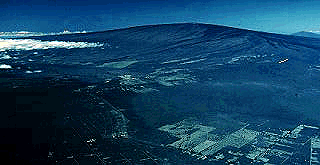
Mauna Loa is the largest volcano on Earth with an estimated volume of 9,600 cubic miles (40,000 cubic kilometers). It makes half of the area of the Island of Hawaii. Mauna Loa began to form nearly a million years ago. There is a caldera, Mokuaweoweo, at the summit and rift zones extend to the northeast and southwest. Mauna Loa is in the shield-building stage and is one of the most active volcanoes on Earth, erupting 15 times since 1900. The last eruption was in 1984 and sent lavas within 4 miles (6.5 km) of Hilo. This photograph looks to the southwest to the northeast rift of Mauna Loa. Volcano Village is in the foreground. The summit of Kilauea volcano is left of center. Photograph by J.D. Griggs, U.S. Geological Survey, January 10, 1985.
May 20, 2003
After nearly 10 years of slight deflation, inflation was observed where lengthening of the lines across the summit caldera was monitored. HVO believes magma replenishment within the volcano's reservoir may be the cause of inflation.
This information was summarized from the GVP/USGS Weekly Volcanic Activity Report
March 18, 2003
In late Feb. 2003, inflation once again occurred at Mauna Loa's Moku`aweoweo summit caldera. Swelling of the volcano's magma reservoir created lengthening, uplift and tilting. Seismicity stayed at low levels.
This information was summarized from the GVP/USGS Weekly Volcanic Activity Report